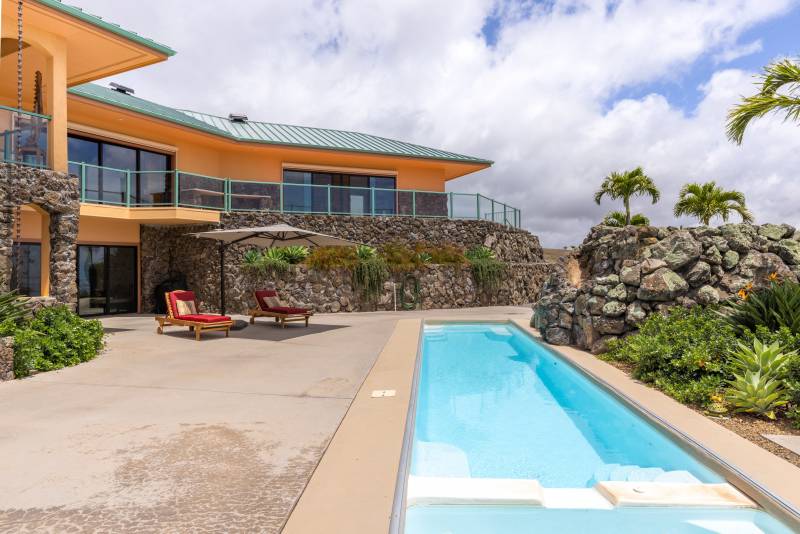It was almost a decade ago when I wrote a post about Ka Makani O Kohala (The Winds of Kohala). And yesterday I found myself once again repeating this line as I stood showing my Puakea Bay Ranch lot listing:
….my stock answer to the question of whether the wind bothers us in North Kohala or the Kohala Coast is, “I am almost always asked that question by prospective real estate buyers. But local residents tend only to talk about the wind when it is absent! Then we start complaining about how muggy and voggy it is.”
Yep. Last week we had kona winds (winds from the south), bringing hazy vog up along the horizon and a rare humidity to the air. And everyone I met on my dog walk, buying groceries at Takata Store, socializing at the Kahilu Theatre before the Robert Cazimero show – everyone was grumbling about the lack of wind.

Trees sculpted by the wind near the entrance to Puakea Bay Ranch show clearly which way the trade winds blow.
Why Kohala People LIKE the Tradewinds
I am not a lazy writer but some of my lines in the 10-year-old blog post are just too good not to repeat (she says *modestly*).
“After a week without the trades, we can no longer see Maui across the channel or the sun drop into the Pacific at sunset…because of the layer of vog (volcanic smog) across the horizon. The air feels heavy; people feel cranky. That’s why we turn sentimental when we hear mele (songs) written about the winds of Kohala. The most famous of these is a love song whose title refers to the good winds of Kohala.”
The particular wind referred to in this song is inuwai, literally “drinking water”. Other chants and songs, such as Hanohano E, talk about the fierceness of the āpaʻapaʻa wind, which would be the one experienced there at Puakea Bay Ranch, where coming from the northeast, the wind sweeps around the corner into the Alenuihaha Channel, making the crossing between Maui and Kohala especially challenging.
Try listening to the music of Waipuna for Kohala-influenced renditions of these songs. Watch this recent video of Aloha e Kohala, listen to the wind, see if you can catch the wind references in the song.
Build or Choose a Home with a Wind-Savvy Orientation or Design
1. Orient the home with lanai and pool on the leeward side.
As you drive up the hill at Puakea Bay Ranch or Kohala Ranch, you will notice homes are oriented with their front entrance towards the wind, and the lanai and pool area towards the ocean and sunset views. That way you can enjoy the lifestyle, sheltered from the wind by the mass of your home.

Photo from my new Kohala Ranch Summit listing. Note how the home wraps around the covered lanai and pool areas for wind protection.
2. Plant windbreaks.
Fast-growing bamboo or areca palms are frequent choices to add wind protection to a home that does not already have it.

Clumping bamboo quickly creates a dense wind break.
3. Capture mauka-makai breezes for natural ventilation.
You will see many homes with louvered (jalousie) and casement windows, providing ventilation without getting blown away by direct wind flow.

Classic in old plantation-era homes; still popular choices in well-designed modern and contemporary styled homes in Hawaiʻi today
Note that the Kohala Coast, including Waikoloa (sometimes referred to as “WaikaBLOWah”) and the resorts, also experience strong trade winds at times. But there is a reason we say maikaʻi — good — are the winds of Kohala. And if wind is really not your thing, perhaps another area of the island, or another island, would be a better choice. I can send you a wind map if that would be helpful.

Leave your opinion here. Please be nice. Your Email address will be kept private, this form is secure and we never spam you.